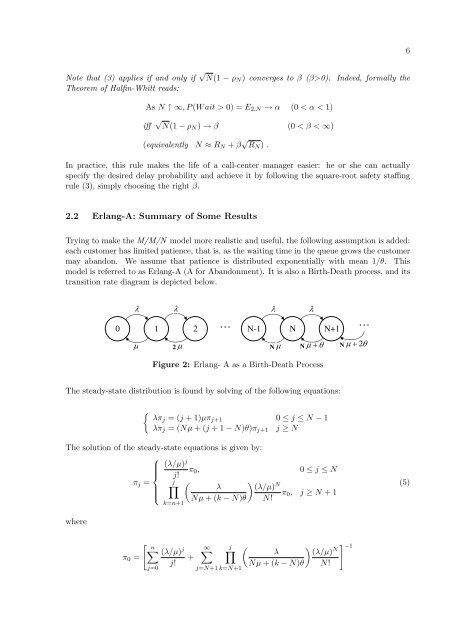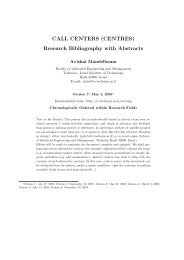Uncertainty in the Demand for Service - Faculty of Industrial ...
Uncertainty in the Demand for Service - Faculty of Industrial ...
Uncertainty in the Demand for Service - Faculty of Industrial ...
You also want an ePaper? Increase the reach of your titles
YUMPU automatically turns print PDFs into web optimized ePapers that Google loves.
Note that (3) applies if and only if √ N(1 − ρN) converges to β (β>0). Indeed, <strong>for</strong>mally <strong>the</strong><br />
Theorem <strong>of</strong> Half<strong>in</strong>-Whitt reads:<br />
As N ↑ ∞, P (W ait > 0) = E2,N → α (0 < α < 1)<br />
iff √ N(1 − ρN) → β (0 < β < ∞)<br />
(equivalently N ≈ RN + β √ RN) .<br />
In practice, this rule makes <strong>the</strong> life <strong>of</strong> a call-center manager easier: he or she can actually<br />
specify <strong>the</strong> desired delay probability and achieve it by follow<strong>in</strong>g <strong>the</strong> square-root safety staff<strong>in</strong>g<br />
rule (3), simply choos<strong>in</strong>g <strong>the</strong> right β.<br />
2.2 Erlang-A: Summary <strong>of</strong> Some Results<br />
Try<strong>in</strong>g to make <strong>the</strong> M/M/N model more realistic and useful, <strong>the</strong> follow<strong>in</strong>g assumption is added:<br />
each customer has limited patience, that is, as <strong>the</strong> wait<strong>in</strong>g time <strong>in</strong> <strong>the</strong> queue grows <strong>the</strong> customer<br />
may abandon. We assume that patience is distributed exponentially with mean 1/θ. This<br />
model is referred to as Erlang-A (A <strong>for</strong> Abandonment). It is also a Birth-Death process, and its<br />
transition rate diagram is depicted below.<br />
<br />
<br />
<br />
. . .<br />
0 1 2 N-1 N N+1<br />
2 <br />
<br />
N<br />
N <br />
Figure 2: Erlang- A as a Birth-Death Process<br />
The steady-state distribution is found by solv<strong>in</strong>g <strong>of</strong> <strong>the</strong> follow<strong>in</strong>g equations:<br />
<br />
λπj = (j + 1)µπj+1<br />
0 ≤ j ≤ N − 1<br />
λπj = (Nµ + (j + 1 − N)θ)πj+1 j ≥ N<br />
The solution <strong>of</strong> <strong>the</strong> steady-state equations is given by:<br />
⎧<br />
⎪⎨<br />
πj =<br />
⎪⎩<br />
(λ/µ) j<br />
π0,<br />
j!<br />
j<br />
<br />
<br />
λ (λ/µ) N<br />
Nµ + (k − N)θ N!<br />
0 ≤ j ≤ N<br />
π0, j ≥ N + 1<br />
where<br />
π0 =<br />
n<br />
j=0<br />
k=n+1<br />
(λ/µ) j<br />
j! +<br />
∞<br />
j<br />
j=N+1 k=N+1<br />
<br />
λ<br />
<br />
(λ/µ) N<br />
Nµ + (k − N)θ N!<br />
N<br />
. . .<br />
2<br />
−1<br />
6<br />
(5)
















